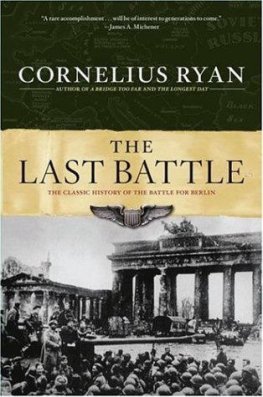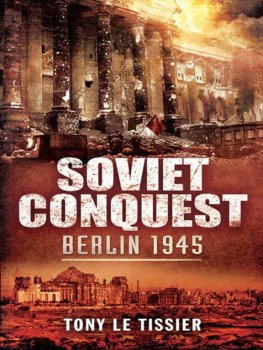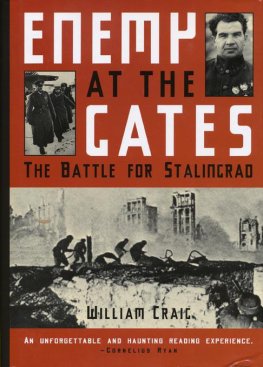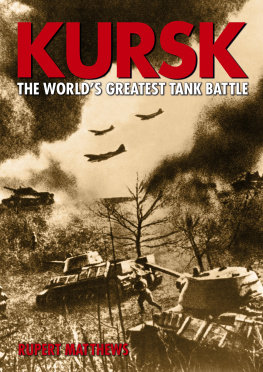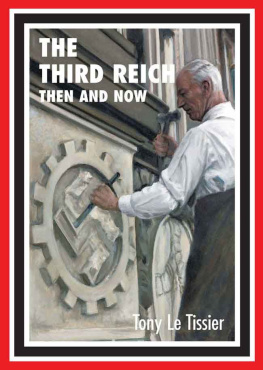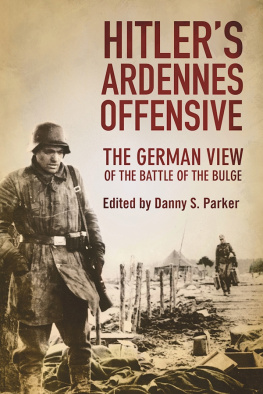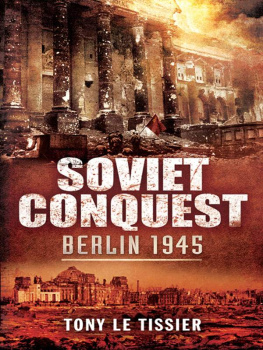
BY CORNELIUS RYAN
A BRIDGE TOO FAR - 1974
THE LAST BATTLE - 1966
THE LONGEST DAY - 1959
Cornelius Ryan

THE LAST BATTLE

SIMON & SCHUSTER PAPERBACKS
New York London Toronto Sydney

SIMON & SCHUSTER PAPERBACKS
Rockefeller Center
1230 Avenue of the Americas
New York, NY 10020
www.SimonandSchuster.com
Copyright 1966 by Cornelius Ryan
Copyright renewed 1994 by Victoria Ryan Bida and Geoffrey J. M. Ryan
All rights reserved, including the right of reproduction in whole or in part in any form.
SIMON & SCHUSTER PAPERBACKS and colophon are registered trademarks of Simon & Schuster Inc.
Manufactured in the United States of America
11 13 15 17 19 20 18 16 14 12
Library of Congress Catalog Card Number: 65-18654
ISBN-13: 978-0-684-80329-6
eISBN-13: 978-1-439-12701-8
ISBN-10: 0-684-80329-1
CONTENTS

Of the events of war, I have not ventured to speak from any chance information, nor according to any notion of my own; I have described nothing but what I saw myself, or learned from others of whom I made the most careful and particular inquiry. The task was a laborious one because eyewitnesses of the same occurrence gave different accounts of them as they remembered, or were interested in the actions of one side or the other. And very likely the strictly historical character of my narrative may be disappointing to the ear. But if he who desires to have before his eyes a true picture of the events which have happened shall pronounce what I have written to be useful, then I shall be satisfied.
THUCYDIDES, Peloponnesian War, Volume 1, 400 B.C.
THIS BOOK IS FOR THE MEMORY OF A BOY WHO WAS BORN IN BERLIN DURING THE LAST MONTHS OF THE WAR. HIS NAME WAS PETER FECHTER. IN 1962 HE WAS MACHINE-GUNNED BY HIS OWN PEOPLE AND LEFT TO BLEED TO DEATH BY THE SIDE OF THE MOST TRAGIC MEMORIAL TO THE ALLIED VICTORYTHE BERLIN WALL.
Foreword
A-Day, Monday, April 16, 1945
The battle for Berlin, the last offensive against Hitlers Third Reich, began at precisely 4 A.M., Monday, April 16, 1945or A-Day as it was called by the Western Allies. At that moment, less than thirty-eight miles east of the capital, red flares burst in the night skies above the swollen river Oder, triggering a stupefying artillery barrage and the opening of the Russian assault on the city.
At about that same time, elements of the U.S. Ninth Army were turning away from Berlinheading back to the west to take up new positions along the river Elbe between Tangermnde and Barby. On April 14 General Eisenhower had decided to halt the Anglo-American drive across Germany. Berlin, he said, is no longer a military objective. When U.S. troops got the word, Berlin, for some of them, was only forty-five miles away.
As the attack began, Berliners waited in the bombed rubble of their city, numb and terrified, clinging to the only politics that now countedthe politics of survival. To eat had become more important than to love, to burrow more dignified than to fight, to endure more militarily correct than to win.
What follows is the story of the last battlethe assault and capture of Berlin. Although this book includes accounts of the fighting, it is not a military report. Rather, it is the story of ordinary people, both soldiers and civilians, who were caught up in the despair, frustration, terror and rape of the defeat and the victory.
Part One
 THE CITY
THE CITY
1

IN THE NORTHERN LATITUDES the dawn comes early. Even as the bombers were turning away from the city, the first rays of light were coming up in the east. In the stillness of the morning, great pillars of black smoke towered over the districts of Pankow, Weissensee and Lichtenberg. On the low clouds it was difficult to separate the soft glow of daylight from the reflections of the fires that blazed in bomb-battered Berlin.
As the smoke drifted slowly across the ruins, Germanys most bombed city stood out in stark, macabre splendor. It was blackened by soot, pockmarked by thousands of craters and laced by the twisted girders of ruined buildings. Whole blocks of apartment houses were gone, and in the very heart of the capital entire neighborhoods had vanished. In these wastelands what had once been broad roads and streets were now pitted trails that snaked through mountains of rubble. Everywhere, covering acre after acre, gutted, windowless, roofless buildings gaped up at the sky.
In the aftermath of the raid, a fine residue of soot and ash rained down, powdering the wreckage, and in the great canyons of smashed brick and tortured steel nothing moved but the eddying dust. It swirled along the broad expanse of the Unter den Linden, the famous trees bare now, the leaf buds seared on the branches. Few of the banks, libraries and elegant shops lining the renowned boulevard were undamaged. But at the western end of the avenue, Berlins most famous landmark, the eight-story-high Brandenburg Gate, though gashed and chipped, still straddled the via triumphalis on its twelve massive Doric columns.
On the nearby Wilhelmstrasse, lined by government buildings and former palaces, shards of glass from thousands of windows glittered in the debris. At No. 73, the beautiful little palace that had been the official residence of German presidents in the days before the Third Reich had been gutted by a raging fire. Once it had been described as a miniature Versailles; now sea nymphs from the ornate fountain in the forecourt lay shattered against the colonnaded front entrance, and along the roof line, chipped and gouged by flying fragments, the twin statues of Rhine maidens leaned headless over the littered courtyard.
A block away, No. 77 was scarred but intact. Piles of rubble lay all around the three-story, L-shaped building. Its yellowish-brown exterior was scabrous, and the garish golden eagles above each entrance, garlanded swastikas in their claws, were pitted and deeply scored. Jutting out above was the imposing balcony from which the world had been harangued with many a frenzied speech. The Reichskanzlei, Chancellery of Adolf Hitler, still remained.
At the top of the battered Kurfrstendamm, Berlins Fifth Avenue, bulked the deformed skeleton of the once fashionable Kaiser-Wilhelm Memorial Church. The hands on the charred clock face were stopped at exactly 7:30; they had been that way since 1943 when bombs wiped out one thousand acres of the city on a single November evening.
One hundred yards away was the jungle of wreckage that had been the internationally famed Berlin Zoo. The aquarium was completely destroyed. The reptile, hippopotamus, kangaroo, tiger and elephant houses, along with scores of other buildings, were severely damaged. The surrounding Tiergarten, the renowned 630-acre park, was a no mans land of room-sized craters, rubble-filled lakes and partly demolished embassy buildings. Once the park had been a natural forest of luxuriant trees. Now most of them were burned and ugly stumps.
Next page

